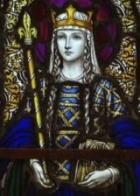St Margaret of Scotland and St Edmund of Abingdon

Queen and patron of Scotland. Born in 1046, Margaret was educated mainly in Hungary, where her family were exiled during the rule of the Viking kings in England. As one of the last members of the Anglo Saxon royal family, she was in danger after the Norman Conquest and took refuge at the court of Malcolm II of Scotland.
Intelligent, beautiful and devout, she married Malcolm in 1069 and the union was exceptionally happy and fruitful for Scotland. The present royal family can trace their descent to Margaret and her daughter Matilda.
Margaret took a keen interest in the country. Through her, the Scottish courts were reformed and the church was revitalised. She founded many monasteries, hostels and churches.
Her private life was devoted to prayer, reading, embroidery, lavish almsgiving and the liberation of slaves. She is said to have had a very civilising effect on her husband, who was initially considered a rather rough character. Her biographer wrote: "He saw that Christ truly dwelt in her heart. What she rejected he rejected. What she loved, he for love of her loved too."
Malcolm could not read but liked to see the books she used at prayer and would have them embellished with gold and silver binding. One of her books survives in the Bodleian library.
Margaret had eight children. Alexander and David became kings of Scotland her daughter Matilda married Henry I of England. She lived just long enough to learn of the tragic death of Malcolm and one of her sons on a military expedition against William Rufus who had confiscated Edgar Atheling's estates. She died at the age of 47 in 1093.
Margaret was buried beside her husband in Dunfermline. Following many miracles, she was canonised in 1250. At the Reformation, both bodies were taken to the Escorial in Madrid. She was named patron of Scotland in 1673.
Today is also the feast of St Edmund of Abingdon
Archbishop of Canterbury. Born in Abingdon in about 1175, to devout parents Reginald and Mabel, Edmund studied in Oxford and Paris as a young man and soon became a respected lecturer in mathematics, dialectics and theology at the Universities of Paris and Oxford.
He was ordained a priest, took a doctorate in divinity and soon became known not only for his lectures on theology but as a popular preacher, spending long years travelling within England, and engaging in 1227 preaching the sixth crusade.
In 1233 he accepted an appointment as Archbishop of Canterbury by Pope Gregory IX. Known as a peacemaker, he was said to combine a gentle personal temperament with a strong public stature. He stood up to King Henry III in defence of Magna Carta was known for his firm but just approach to civil and Church government.
He also worked for strict observance in monastic life and negotiated peace with Llywelyn the Great. His policies earned him hostility and jealousy from the king, and opposition from several monasteries and from the clergy of Canterbury Cathedral. He died in France at the beginning of a journey to Rome in 1240. He was canonised in 1246.
He is patron of Abingdon, the Diocese of Portsmouth, St Edmunds College Cambridge, St Edmund College Oxford. There is a Shrine to St Edmund at Pontigny Abbey France.
( One of ICN's favourite bloggers, the Clerk of Oxford, has written a fascinating piece about St Edmund of Abingdon's life. See: https://aclerkofoxford.blogspot.com/2017/11/st-edmund-and-abingdon.html )












